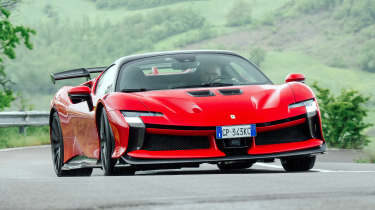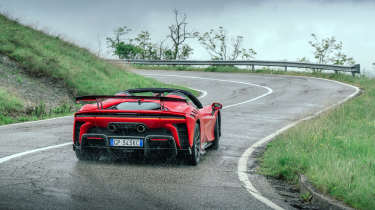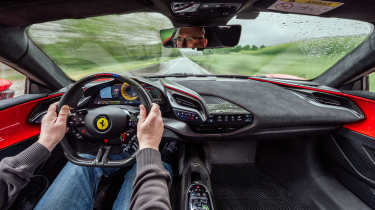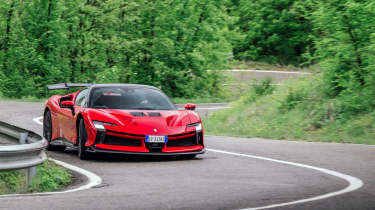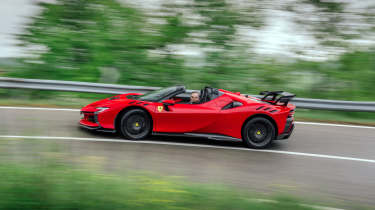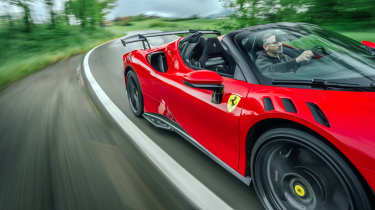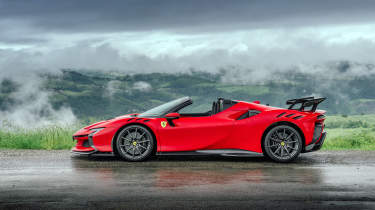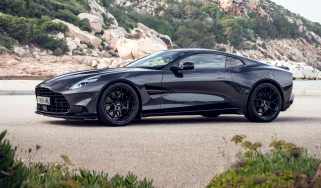Ferrari SF90 XX Spider 2024 review – a 1016bhp open-top adrenaline hit
The Spider version of the SF90 XX provides our first taste of Ferrari’s track-focused 1016bhp hypercar on the road
It’s always special, turning up at the Ferrari factory to collect a car. Just being allowed through the gate feels like a privilege, as behind you sightseers edge as close as they dare to the threshold while from across the road their friends take photos that frame them below the iconic Ferrari sign. Filling one of the parking spaces is ‘our’ car, an SF90 XX Spider, its glowing red paintwork beading with rain. We pop indoors to complete the paperwork and find the area filled with the happy hubbub of middle-aged tifosi taking group photos in front of the wall-mounted F1 car while they await their factory tour.
I’m lucky enough to have been here a few times but I confess to a little trepidation today, mostly because of the weather. It’s barely above freezing and Lucia, who is doing the handover, is strongly suggesting we head for the Adriatic coast rather than the nearby hills because they had a massive fall of snow yesterday. The car, she points out, is not equipped with snow chains. Indeed, but at least its slender-spoked carbon wheels are shod with Bridgestone S005s rather than the semi-slick Michelin Cup 2 Rs that the SF90 XX Stradale wore when my colleague, Dickie Meaden, came here to drive it late last year (evo 318).
More reviews
> The £3.1m Ferrari F80 is a V6 LaFerrari successor
Until now, cars from the XX programme have been extreme, track-only developments of Ferrari’s road cars – Enzo, 599 and LaFerrari – created exclusively for ‘client test drivers’ to enjoy at Ferrari-run test days. Although evolved with the same philosophy, the SF90 XX is the first road-legal XX car. The most obvious expression of this track-focused development is the huge, fixed rear wing, literally the central plank of a new aerodynamic strategy that delivers considerably more downforce. The front end has been revised too, improving cooling of the SF90’s hybrid electric hardware and helping liberate an additional 13bhp, while detail work on the 4-litre, twin-turbo V8 adds another 17bhp, lifting total output from 986 to 1016bhp.
When Dickie tried the Stradale, he drove a number of sets of laps at Fiorano pursuing another SF90 XX piloted by legendary test driver Raffa de Simone and came away deeply impressed with the car’s abilities around the manicured environs of the Ferrari test track. However, with a soupcon of irony, there was no road driving so he was left to speculate how the first XX road car might deal with the cut and thrust of urban traffic and the give and take of a country road. He reckoned it would do alright, its steering having a natural feel and its chassis having some roll and pitch.
He was right, as we will shortly discover. Initially, as I drop into the driver’s seat, the complexity of the switchgear and instruments is bordering on overwhelming. There are two manettinos, the original one for the chassis and an ‘eManettino’ for the hybrid powertrain. I double-tap the haptic start/stop button, select Wet for the chassis and H for hybrid, give the throttle a squeeze and we move off with a light ‘whoosh’ of electric power.
The first joy is the steering, which is perfectly weighted and direct but not overly bright. There’s a lovely, soft nap to the wheel’s leather trim, too. The second joy is that the SF90 XX rides really well, taking the sting out of all manner of road roughness, of which there is plenty. So here we are, drifting along in early morning traffic, electric motors humming and whining, like we’re in a GT car. I was expecting edge, angst, pent-up aggression from Ferrari’s most potent road car ever, and a track-ready one at that. Instead I have great visibility, decent refinement and a relaxed demeanour. It may be the calm before the storm – the twin-turbo V8 hasn’t fired up yet – but I have a good feeling about the feistiest SF90.
Accelerating to blend with traffic on a faster road, I’m expecting – hoping – the SF90’s going to do that hybrid WEC sportscar thing. You know, where they accelerate away from a pit stop on a whine of electric power and then the ICE bursts loudly into life… but no, we slot in having not needed more than the electric motors’ 230bhp.
It’s a sparsely trimmed interior with no carpets, fabric-trimmed sills and a lot of naked carbonfibre, but it’s not as bare as, say the 488 Pista, which sounded hollow, like an empty room. Some plushness is provided by Alcantara trim for the facia, door-tops and the seats, which are carbon-framed and some of the lightest Ferrari has even made but happily do offer backrest angle adjustment.
Finally, a firm prod of the throttle heading uphill wakes the engine, which erupts into life. It’s almost comical because it sounds like a lion roaring down a drainpipe, valves-open loud and at a high idle because it’s still cold. And then it’s gone, autonomous hybrid mode reverting to electric again. As the miles build and the electrical well drains, the V8 fires more regularly, becoming smoother and more refined but retaining a more detailed and visceral note compared to the stock SF90. This is thanks to the revised engine sound enhancer, which takes pulses from both the intake and the exhaust manifolds.
Once everything is thoroughly warmed through, it’s a lovely engine note, smoother-edged and more refined than that of McLaren’s similar unit. Oddly, although it shouldn’t come as a surprise, at low speed the car feels more positively connected to the throttle when it’s using the electric motors rather than the V8, even though the latter is linked to an eight-speed DCT gearbox. Switch up the eManettino to ‘Qualify’ mode and you get the best of both, with full electrical energy getting the car moving instantly before the V8 picks up and kicks in with full boost. I don’t mind admitting that it takes a while feeling for the level of grip before I summon the courage to keep the throttle pinned to the red line, not least because for the full effect you need the regular manettino dialled to CT Off so that the traction control doesn’t restrict the delivery.
Just turning the manettino from Wet to Race ramps things up, sharpening the response, firming up the damping appreciably and opening the tailpipe valves so that the cockpit fills with the low, resonant growl of the V8 even when you’re ambling. The roads we’re on aren’t the widest or smoothest, so a press of the Bumpy Road button restores the suppleness and hopefully helps traction too. Snap open the throttle and the car lunges forward instantly, nose lifting, tail squatting, and a fraction later the V8 escalates things wildly, acceleration spiking as its note thins and then hardens again as it hits peak boost and torque. It’s literally head-spinning; the step-off from a rolling start is sudden and slip-free and you never get the chance to recover before full boost hits. I don’t even make it to the red line, seeing only the first red shift light blink, but zero to 62mph in less than 2.5sec in ideal conditions? Yeah, I reckon.
The original SF90 is only a fraction slower, but when we first tried it at Car of the Year in 2021 it spooked us; its chassis never felt settled, so you couldn’t exploit its extraordinary performance. Subsequent examples were as it should have been from the start, but the SF90 XX feels like another huge step on. However, there are a couple of features that are extraordinarily irritating and that I don’t recall from the original SF90: Lane Keep Assist and Traffic Sign Assist. Get near a white line and you’ll hear a sound like a 1980s Trimphone. Exceed the posted limited and there’s a soft toot that sounds like the horn of a disapproving Fiat 500 tucked up behind you. Which might sound funny, but after hours of them chiming in, I was ready to reach for the wiring at the back of the instrument panel. The only good thing is that they’re drowned by the sound of the engine when you’re pressing on.
I’ve not put the roof down yet. In some ways, building a Spider version of such a track-capable car doesn’t make sense, because it’s heavier in the wrong place, but all 799 Stradale coupes and 599 Spiders were sold out in a flash, so Ferrari knows its market. Roof up, you could easily mistake the Spider for the coupe, the only difference being the coupe has a sloping rear, continuing the line from the trailing edge of the roof to the glass engine cover. On the Spider this section is stepped, with a flat rear deck that hinges open to swallow up the folded, two-part roof. This means that in the Spider you get a small rear window (which can be lowered) and a view out the back.
The penalty is an increase in weight of 100kg over the coupe, though for me there’s an aesthetic cost, too, because roof stowed I don’t think it looks as good as the coupe, losing the visual tension provided by the clean roofline from nose to stern. It’s all a bit too busy. Despite the step, Ferrari says that the aero strategy for both versions remains the same, so the effect of that huge, fixed rear wing (530kg of downforce at 250kph/155mph) should be the same.
Helping to balance this is a new front splitter and a revised angle for the front radiator, which cools the electric motors, inverter and batteries, and now vents, à la 296 GT3, through the top of the bonnet, providing a 20 per cent increase in front downforce (but also consuming all meaningful luggage space). Trios of vents on the front and rear wings release pressure in the wheel-wells and also increase downforce, and there’s lots of discreet aero work going on beneath of course.
The key benefit of the folding roof, which stows in 14 sec, is it gets you closer to the elements, though any sensible folk would want to keep them out on a day like today, with an ambient temperature of 4deg and sleet hitting the windscreen. On the upside, the sound of the V8 working hard and the audible punctuation of its sportier upshifts is thrilling as it’s delivered with much greater clarity, as if you’ve just removed ear plugs.
There’s a further price to pay, though, and it’s a surprising one given that the design of the SF90, particularly the positioning of the window into the engine bay, suggests that it was conceived as both Spider and coupe from the outset. That price is that with the roof stowed, the car’s structural stiffness is clearly reduced. You’d think that with its track-focused abilities the SF90 XX might be beefed-up a little, but even quite modest bumps have the steering jiggling in your hands and the rear-view mirror shaking.
This is a shame because the steering and the ride still impress. Against advice, we’ve headed for the hills and, although we can see snow on distant hilltops, we find none ourselves so it’s just low temperatures that we have to contend with. The overall poise and dynamic cohesion are still encouraging, the steering calm on and around centre but quickening as you apply more lock. So, in the interests of research, I select Qualify and CT Off and discover it’s possible to make brisk progress with judicious use of the massive performance, but the tyres seem to be struggling with the surface temperature.
Push hard into a turn and all is good up to a point, and then the front washes wide. That’s useful feedback because the chances are the rear will probably do the same, and so it proves. Gradually applying a little more throttle through the same corner, the rear eventually breaks away, the drop-off in grip abrupt, and as with the front, you can feel the tread-blocks juddering mildly across the chilly asphalt.
These roads aren’t wide enough or warm enough – and I’m not brave/daft enough – to see what happens when boost comes in mid-corner, though the way the rear tyres fizz up when the boost hits hard in a straight line offers a pretty good idea. A list of dynamic aids as long as your arm – eSSC 1.0, E4WD, SCM, FDE 2.0, EPS – isn’t going to be much help if you haven’t got any grip. The surface is never fully dry, but before returning the car we do get a few opportunities to flatten the throttle and keep it pinned to the red line, and it is epic, particularly that mid-boost phase where the delivery hardens and kicks you in the kidneys.
The Spider gets you closer to the action but the Stradale would be our choice, for its greater integrity, fidelity and looks. But it’s frustrating that we still don’t have a definitive impression of the SF90 XX’s on-road ability. We know that it’s a fantastic track car, scintillatingly fast and surprisingly malleable and engaging, and after this drive we know it has superb steering and surprising dynamic bandwidth. Thanks to its damping range and hybrid powertrain, it can do the commute in EV mode and also rip around a track, entertaining as it deploys all 1016bhp. And it feels like it will excel at everything in between, making it a much more useable car than its aggressive looks and XX moniker would suggest. Hopefully one day soon we’ll get to find out for certain.
Price and rivals
It’s a small niche that the SF90 XX Spider operates in, and that’s not only because it costs from £733,000. There are other track-biased hypercars, but few, other Aston Martin’s Valkyrie Spider at £2.365m, are available without a roof. Bugatti will surely offer an open top version of its Tourbillon in due course, and GMA will sell you a T.33 Spider for £1.8m, although neither are likely to be as track-focused as the Ferrari despite promising remarkable levels of performance.

